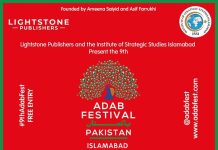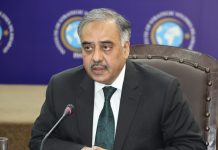Remarks by DG ISSI Ambassador Sohail Mahmood, at Seminar “Reflections of Resilience: Showcasing Kashmiri Identity & Solidarity through Art” ISSI,
1 February 2024

Ambassador Khalid Mahmood, Chairman BOG, ISSI
Respected Altaf Wani Sahib, Chairman KIIR,
Honourable Mushaal Mullick Sahiba, Special Assistant to Prime Minister,
Esteemed Speakers,
Dear Students,
Assalam o Alaikum & Good Morning,
It is great privilege to welcome you all to our this year’s commemoration of the Kashmir Solidarity Day. The Institute of Strategic Studies Islamabad takes pride in hosting this event, the first of its kind by us, which aims to transcend traditional political and diplomatic lenses and delve into the rich tapestry of Kashmiri resistance through literary and cultural means.
We have a group of distinguished speakers representing the political movement, the academia, the think-tanks, and the art community. Their contributions will undoubtedly enrich our deliberations as they will illustrate different dimensions of this subject from their respective vantage points.
I would like to extend a special welcome to Ms. Mushaal Hussein Mullick, a distinguished figure who serves as a strong voice on Kashmir and is currently the Special Assistant to the Prime Minister on Human Rights and Women Empowerment. Her untiring endeavours and passionate advocacy have significantly contributed to the discourse surrounding Kashmir and the promotion of this just cause. We are honored to have her with us today.
Our seminar, titled “Reflections of Resilience: Showcasing Kashmiri Identity and Solidarity through Art,” underscores the power of artistic expression in highlighting the deep-rooted struggles, trauma, and fractured identities faced by the people of Kashmir. It is important to recognize that beyond the political discourse, the cultural and artistic mediums serve as powerful vehicles for conveying the tales of lost homelands and the resilience of a community caught in the throes of conflict.
In conjunction with our seminar, we are delighted to organise an exhibition to serve as a visual testament to the resilience and rich cultural heritage of Kashmir. The exhibition showcases a diverse array of artworks, including the powerful resistance artwork in the form of paintings, illustrations, books from history to literature, and various other artistic expressions encapsulating the essence of the Kashmiri struggle. Additionally, the exhibition highlights the exquisite craftsmanship of Kashmiri artisans, featuring a display of traditional handicrafts that are not only illustrative of the region’s artistic prowess but also a celebration of its vibrant cultural identity.
The significance of Kashmir Solidarity Day lies in its recognition of the struggles waged by the Kashmiri people and the importance of global solidarity with them. It serves as a reminder that the Kashmir conflict is not merely a regional hotspot but also a matter of profound international concern. By commemorating this Day, we emphasize the need for a peaceful and just resolution that respects the rights and aspirations of the Kashmiri people.
The historical context of the Kashmir conflict, rooted in the partition of British India in 1947, has left a lasting impact on the region. The geopolitical dynamics have led to a protracted and complex struggle. It is crucial to recognize the historical grievances, the impact of militarization and caging of the ‘heaven on earth’, and the effects of persistent denial of the inalienable right of Kashmiri people to self-determination.
Art, in its myriad forms, has long served as a powerful instrument of resistance, transcending the boundaries of language and ideology. In the context of the Kashmir conflict, it becomes a poignant means through which the unheard voices find expression. The canvas becomes a battleground, and each stroke of the brush or pen is a defiant act against silence. Whether it be Mir Suhail Qadiri’s political cartoons, Malik Sajad’s graphic narratives, the haunting verses of Agha Shahid Ali, or the novels of Basharat Peer and Mirza Waheed, art becomes a mirror reflecting the realities of a conflict-stricken land. It defies oppression by bearing witness, immortalizing the narratives of trauma, resilience, and the collective struggle for identity.
Through the lens of the artist, the world witnesses the intangible pain and the unspoken tales of a people reeling under occupation or caught in the crossfire. It is not merely brushstrokes on a canvas or words on a page; it is a manifestation of resistance, a refusal to let the struggles be relegated to the periphery of collective consciousness. Art provides a visual and emotional bridge, connecting hearts and minds to the lived experiences of those suffering relentless oppression and still struggling for their rights. It has the power to transcend political rhetoric, fostering empathy and understanding that goes beyond geographical boundaries. In this sense, the well-acclaimed artists, like Mir Suhail Qadiri, Malik Sajad, Saqib Bhat and several others are not just creators; they are torchbearers of a profound resistance, ensuring that the stories of Kashmir are etched into the global conscience.
Moreover, art as resistance is an act of reclamation, a reclaiming of narratives and identities that may otherwise be overshadowed by geopolitical complexities. It empowers individuals to assert their agency in the face of adversity, reminding the world that the human spirit cannot be stifled. The vibrant strokes of a painting, the carefully crafted lines of a cartoon, or the evocative verses of poetry transcend the limitations of conventional dialogue. Art becomes a universal language, a bridge that enables the global community to connect with the shared human experience of suffering, endurance, and the unwavering quest for justice. As we navigate the realms of art in the context of the Kashmir conflict, let us recognize and celebrate its role not just as an aesthetic pursuit but as a formidable force that propels the wheels of resistance forward, creating ripples that resonate far beyond the canvas.
As we gather here today, let us collectively appreciate the multifaceted lens through which we explore the Kashmir conflict. By showcasing the artistic and literary expressions of Kashmiri identity and resilience, we hope to elevate the visibility of Kashmir and its people. Through these soft mediums of an unflinching resistance, we aim to bring forth uncorrupted, genuine narratives that reflect the heart and soul of the Kashmiri struggle.
In closing, I extend my gratitude to all the participants, artists, and attendees who have joined us for this ground-breaking event. My special thanks to all the students who took part in the art competition. Also, deep appreciation for the India Study Centre (ISC) team, ably led by Dr. Khurram Abbas with special contributions of Ms. Uroosa Khan and Mr. Ahmad Khan.
May this event serve as a platform for further dialogue, understanding, and, most importantly, a celebration of the indomitable spirit of the Kashmiri people. Moreover, we invite all attendees to explore the exhibition, where art serves as a medium to bridge understanding and appreciation for the multifaceted narratives of Kashmir.
Thank you.















